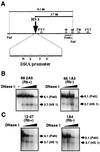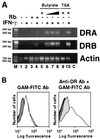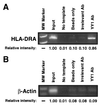Histone deacetylase activity represses gamma interferon-inducible HLA-DR gene expression following the establishment of a DNase I-hypersensitive chromatin conformation
- PMID: 11533238
- PMCID: PMC99796
- DOI: 10.1128/MCB.21.19.6495-6506.2001
Histone deacetylase activity represses gamma interferon-inducible HLA-DR gene expression following the establishment of a DNase I-hypersensitive chromatin conformation
Abstract
Expression of the retinoblastoma tumor suppressor protein (Rb) is required for gamma interferon (IFN-gamma)-inducible major histocompatibility complex class II gene expression and transcriptionally productive HLA-DRA promoter occupancy in several human tumor cell lines. Treatment of these Rb-defective tumor cell lines with histone deacetylase (HDAC) inhibitors rescued IFN-gamma-inducible HLA-DRA and -DRB mRNA and cell surface protein expression, demonstrating repression of these genes by endogenous cellular HDAC activity. Additionally, Rb-defective, transcriptionally incompetent tumor cells retained the HLA-DRA promoter DNase I-hypersensitive site. Thus, HDAC-mediated repression of the HLA-DRA promoter occurs following the establishment of an apparent nucleosome-free promoter region and before transcriptionally productive occupancy of the promoter by the required transactivators. Repression of HLA-DRA promoter activation by HDAC activity likely involves a YY1 binding element located in the first exon of the HLA-DRA gene. Chromatin immunoprecipitation experiments localized YY1 to the HLA-DRA gene in Rb-defective tumor cells. Additionally, mutation of the YY1 binding site prevented repression of the promoter by HDAC1 and partially prevented activation of the promoter by trichostatin A. Mutation of the octamer element also significantly reduced the ability of HDAC1 to confer repression of inducible HLA-DRA promoter activation. Treatment of Rb-defective tumor cells with HDAC inhibitors greatly reduced the DNA binding activity of Oct-1, a repressor of inducible HLA-DRA promoter activation. These findings represent the first evidence that HDAC activity can repress IFN-gamma-inducible HLA class II gene expression and also demonstrate that HDAC activity can contribute to promoter repression following the establishment of a DNase I-hypersensitive chromatin conformation.
Figures









Similar articles
-
Histone deacetylase 1/mSin3A disrupts gamma interferon-induced CIITA function and major histocompatibility complex class II enhanceosome formation.Mol Cell Biol. 2003 May;23(9):3091-102. doi: 10.1128/MCB.23.9.3091-3102.2003. Mol Cell Biol. 2003. PMID: 12697811 Free PMC article.
-
Oct-1 maintains an intermediate, stable state of HLA-DRA promoter repression in Rb-defective cells: an Oct-1-containing repressosome that prevents NF-Y binding to the HLA-DRA promoter.J Biol Chem. 2004 Jul 9;279(28):28911-9. doi: 10.1074/jbc.M403118200. Epub 2004 Apr 22. J Biol Chem. 2004. PMID: 15105429
-
Retinoblastoma protein expression facilitates chromatin remodeling at the HLA-DRA promoter.Nucleic Acids Res. 1997 Dec 15;25(24):5095-102. doi: 10.1093/nar/25.24.5095. Nucleic Acids Res. 1997. PMID: 9396821 Free PMC article.
-
Inhibition of histone deacetylase activity by butyrate.J Nutr. 2003 Jul;133(7 Suppl):2485S-2493S. doi: 10.1093/jn/133.7.2485S. J Nutr. 2003. PMID: 12840228 Review.
-
Dietary HDAC inhibitors: time to rethink weak ligands in cancer chemoprevention?Carcinogenesis. 2006 Feb;27(2):344-9. doi: 10.1093/carcin/bgi253. Epub 2005 Nov 2. Carcinogenesis. 2006. PMID: 16267097 Free PMC article. Review.
Cited by
-
A Ménage à trois: NLRC5, immunity, and metabolism.Front Immunol. 2024 Jul 5;15:1426620. doi: 10.3389/fimmu.2024.1426620. eCollection 2024. Front Immunol. 2024. PMID: 39035010 Free PMC article. Review.
-
Absent in Melanoma 2 (AIM2) is an important mediator of interferon-dependent and -independent HLA-DRA and HLA-DRB gene expression in colorectal cancers.Oncogene. 2012 Mar 8;31(10):1242-53. doi: 10.1038/onc.2011.320. Epub 2011 Aug 1. Oncogene. 2012. PMID: 21804607 Free PMC article.
-
Human cytomegalovirus gene expression during infection of primary hematopoietic progenitor cells: a model for latency.Proc Natl Acad Sci U S A. 2002 Dec 10;99(25):16255-60. doi: 10.1073/pnas.252630899. Epub 2002 Nov 27. Proc Natl Acad Sci U S A. 2002. PMID: 12456880 Free PMC article.
-
Histone deacetylase 1/mSin3A disrupts gamma interferon-induced CIITA function and major histocompatibility complex class II enhanceosome formation.Mol Cell Biol. 2003 May;23(9):3091-102. doi: 10.1128/MCB.23.9.3091-3102.2003. Mol Cell Biol. 2003. PMID: 12697811 Free PMC article.
-
The RB tumor suppressor at the intersection of proliferation and immunity: relevance to disease immune evasion and immunotherapy.Cell Cycle. 2015;14(24):3812-9. doi: 10.1080/15384101.2015.1010922. Cell Cycle. 2015. PMID: 25714546 Free PMC article. Review.
References
-
- Baskar S, Azarenko V, Garcia Marshall E, Hughes E, Ostrand-Rosenberg S. MHC class II-transfected tumor cells induce long-term tumor-specific immunity in autologous mice. Cell Immunol. 1994;155:123–133. - PubMed
-
- Baskar S, Clements V, Glimcher L, Nabavi N, Ostrand-Rosenberg S. Rejection of MHC class II-transfected tumor cells requires induction of tumor-encoded B7-1 and/or B7-2 costimulatory molecules. J Immunol. 1996;156:3821–3827. - PubMed
-
- Bennett M K, Tawny T N, Jyoti N A, Rosenfeld J M, Osborne T F. Co-stimulation of promoter for low-density lipoprotein receptor gene by sterol regulatory element-binding protein and Sp1 is specifically disrupted by the Yin-yang 1 protein. J Biol Chem. 1999;274:13025–13032. - PubMed
Publication types
MeSH terms
Substances
Grants and funding
LinkOut - more resources
Full Text Sources
Other Literature Sources
Research Materials
Miscellaneous
